Peter MALONE
Saturday, 18 September 2021 19:43
Sextette
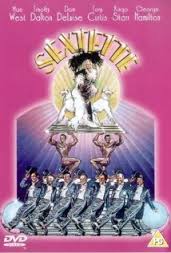
SEXTETTE
US, 1978, 91 minutes, Colour.
Mae West, Walter Pidgeon, Timothy Dalton, Tony Curtis, Dom de Luise, George Raft, Ringo Starr, Keith Moon, George Hamilton, Alice Cooper, Regis Philbin.
Directed by Ken Hughes.
A very odd film. It has to be seen to be believed. Mae West made a great impact in the thirties and forties for her humour, sexual innuendo. She also made an impact on male audiences in the thirties and forties with her sex appeal and her emphasis on sexuality - and the life-saver jacket of World War II!
She made an unwise comeback in the film version of Gore Vidal’s Myra Breckenridge. She played the agent Letitia van Allen who was meant to be 45; Mae West was 80. She was heavily made up and had glamorous clothes and blonde wig. Instead of looking made up, she looked rather embalmed. She went through her bumps and grinds and innuendo in the way she did forty years earlier. Seeing her acting in this way at her age was in many ways embarrassing.
It is a surprise, therefore, to watch her in her mid-eighties, trying to do the same kind of thing in Sextette. The screenplay is based on one of her early plays - a corny plot of a famous actress marrying an English lord and becoming involved in international affairs, her being able to have a hold over the diplomats because of her sexual relationships (with the connivance of the American government)! Her husband, who seems a fool, is in fact an English agent. The director. Ken Hughes, who has made such films an Of Human Bondage and Arrivederci Baby and Chitty Chitty Bang Bang, does his beet, with tongue in cheek, with the material and the cast.
Mae West is her old self with the same gestures but at times she seems hardly able to walk and shuffles along. While she is often very funny, she also seems in many ways pathetic. She apes her past and this is regrettable.
Some brave men appear with Mae West and allow themselves to be somewhat overshadowed - although they actually play their roles rather well. Timothy Dalton is all seriousness as Lord Barrington seemingly innocent, very British, the butt of a lot of jokes about homosexuality and trying his best to sing and be romantic with West. As her previous husbands, Tony Curtis has a chance to do a skit on a Russian diplomat, Ringo Starr be a European film director, George Hamilton pretends to be a godfather type (with themes from the Godfather).
The film, however, is very much carried by Dom de Luise as Mae West's agent. He has some funny lines, even stops to do a satiric song, and keeps the pace moving. Various people like Keith Moon and Alice Cooper have turns and in the supporting cast we find George Raft doing a walk on scene and Walter Pidgeon, looking at Mae West in laughing disbelief at times, as the chairman of the international meeting. Media personalities like Rona Barrett also appear in the film. Mae West's one-liners, even with their broad unsubtlety, are often very funny. However, the cast sometimes breaks into song, there are dancing scenes so artificial that they are vivid reminders of the styles of the thirties and the whole enterprise looks 30s creaky. The tongue-in-check attitude means that the film gets away with a lot of its creakiness. Certainly a curiosity item.
Published in Movie Reviews
Published in
Movie Reviews
Tagged under
Saturday, 18 September 2021 19:43
Shadow of a Doubt / 1943
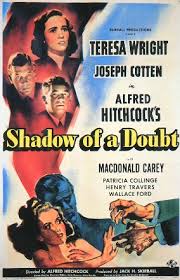
SHADOW OF A DOUBT
US, 1943, 108 minutes, Black and white.
Teresa Wright, Joseph Cotten, Macdonald Carey, Henry Travers, Patricia Collinge, Hume Cronyn, Wallace Ford.
Directed by Alfred Hitchcock.
According to Hitchcock himself, Shadow of a Doubt was one of his favourite films. After a long career in England, he came to the United States for Rebecca in 1940. It won the Oscar for best film. He followed that with such classics as Suspicion and a number of films concerning the war including Foreign Correspondent and Saboteur. He was then to go on to make Lifeboat and Spellbound.
This film is a domestic thriller. The screenplay was written by playwright Thornton Wilder (Our Town). It focuses on a young woman who invites her uncle to stay with the family in California. She feels he would brighten the family up. However, his influence is far different because he is, in fact, the Merry Widow serial killer. After lulling the family into complacency, the niece begins to have some kind of suspicions, shadows of doubt, and her life is threatened.
Teresa Wright is the niece. Joseph Cotten is Uncle Charlie. He was to work with Hitchcock in Under Capricorn. Wallace Ford portrays one of the detectives searching for Uncle Charlie as does Macdonald Carey.
The film was remade for television in 1991 with Mark Harmon as Uncle Charlie.
1. The quality of this Hitchcock film? Thriller, suspense? A portrait of America? Made during the war? One of Hitchcock's own favourites?
2. The tone of the titlep the overtones of shadow, doubt? In whose mind? The audience's mind? Shadow of a doubt about guilt, crime? Identification with the people in the film, the transfer of guilt and responsibility? Audience suspense?
3. Black and white photography, the use of shadows, as when Charlie's train arrived? Light and darkness, night and day? The importance of the build-up of the small American city? The authenticity of streets, homes, shops? Detail? (The contribution of Thornton Wilder and his plays and writings about small towns?) How important was the atmosphere of the town for the thriller, understanding of the people and the themes?
4. The importance of the motif of The Merry Widow, as seen during the credits, as a chorus of dancers throughout the film? The theme music itself, when it was whistled, hummed? People wanting to identify Charlie and his trying to get people not to identify it?
5. What happened to the audience during the opening sequence, with the presentation of Charlie, lying on his bed, a mysterious figure, in the dark during the daylight, the hostility to his landlady, suspicions? The irony of people chasing him and wanting to visit him? His being elusive and escaping? Audience hostility, fear for family and its very homely atmosphere? The mini-crimes within the family, The personality of mother, father, children? Charlie and her not feeling well, depressed? An important thematic introduction to the family for the later developments?
7. The focus on the the Charlies, especially the bond of the telegram? The bonds of the common relationship and love? Indications of a kind of telepathy? A sympathy between the two which was to deteriorate?
8. The build-up to the arrival of Uncle Charlis. the whole family in eager anticipation? The black cloud over the station and his arrival?
9. Uncle Charlie as seen within the family context, his charm, pleasantness? Their welcoming him? The mother's joy in having her brother present? The father's reticent attitude? Charlie and her delight to have her Uncle present? The ease with which he settled, the joy that he gave, his charming talk, his plans? The plans and the overtones of money and the ambiguity of this?
10. How well did the film portray mother and father, attention to character in particular action? The root of the family?
11. The importance of the interaction of the two Charlies? The happiness, the begining of suspicion, their kinship and yet Charlie's tear? The paper and the taking cut of the item about the murders? The strange circumstances of the money?
12. The presence of the detectives, the confronting of Charlie? The importance of her looking up the newspapers?
13. The audience growing more suspicious with wondering what Charlie would do about her Uncle? What decisions did the audience make?
14. Charlie becoming more auspicious? The mysterious nature
of his attempts to kill Charlie? Their verbal clashes? The build-up to the outing? The garage and Charlie's escaping from death?
15. The importance of the night of Uncle Charlie's talk? The importance of the ring? The pressure on Uncle Charlie to get the ring back?
16. The irony of his decision to leave? Charlie's presence on the train? The clash and the sudden impact of Uncle Charlie's death?
17. Why the cover-up? For the benefit of the family? Charlie and the detectives' discussion about what had really happened?
18. How sympathetic a murderer was Uncle Charlie? Did his long speeches about his philosophy, motives really help audience sympathy and understanding? How sympathetic a villain? How effective a thriller? (The comedy about thrillers and this especially in the discussions between father and Herbie Hawkins the neighbour - and the irony of Herbie Hawkins seeing Charlie in the garage and contributing to the solution?)
Published in Movie Reviews
Published in
Movie Reviews
Tagged under
Saturday, 18 September 2021 19:43
Shadow of the Cat

SHADOW OF THE CAT
UK, 1961, 79 minutes, Black and white.
Conrad Phillips, Barbara Shelley, Andre Morell, Catherine Lacey, Freda Jackson.
Directed by John Gilling.
Shadow of the Cat is a brief horror film. It is considered as one of the Hammer Studios classics. It is different from their regular Frankenstein and Dracula films – but creates great atmosphere.
It takes a familiar story, the old woman who is murdered by her relatives for her money but whose cat wreaks revenge on the greedy relatives.
Barbara Shelley and Andre Morell lead the relatives in the quest for the money. However, director John Gilling (Plague of the Zombies, The Reptile) creates great black and white atmosphere with the menace of the cat and its attack on the relatives. This is a horror film for those who are aficionados of the genre.
1. What is the main impact of horror films? Why do audiences enjoy them so much? The fantasy, the excitement? The morbid overtones of horror films?
2. How succesful a horror film was this? The recreation of the period atmoshere in detail? The black and white photography?
3. How succesful was this film as a murder thriller? Its use of the conventions of the murder/thriller?
4. Audience response to the opening of the film? The atmosphere of the house, curiosity about Ella? Sharing her fear? The brutality and mystery of her death?
5. How central was the cat? The focus on the cat's eyes? The technique of elongating the focus to show what the cat saw? Audience identification with the cat, watching the murder, frightening the murderers? Audience anticipation of the movements of the cat? Horror at the cat's vengeance? Techniques of the cat's frightening the people to death? The thematic significance of the title?
6. How were the characters subordinate to the cat? Walter and his greed? His style of behaviour? His response to the cat? His defiance, his fear, his death? The fear and brutality of Andrew and Clara? Clara's hysterics? The family and the quest to murder the cat? Their brutal deaths? The contrast with death and their ability to handle the cat as a pet? Michael as the hero investigating the murders? The police and their attitudes?
7. How conventional were all the characters; hero and heroine, villain, villainous family and servants, conventional police? How convincing were the for this kind of film?
8. How contrived were the deaths? Audience anticipation of then? The enjoyment of these deaths and their anticipation?
9. On what values of good and evil do such films work? Presuppositions in the audience about judging who is good and who is evil? The way the good characters were filmed, the evil e1Jaracters?
10. Was this a successful horror thriller?
Published in Movie Reviews
Published in
Movie Reviews
Tagged under
Saturday, 18 September 2021 19:43
Shadow on the Land
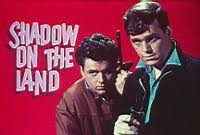
SHADOW ON THE LAND
US, 1968, 100 minutes, Colour.
Jackie Cooper, John Forsythe, Gene Hackman, Carol Lynley, Janice Rule, Michael Margotta.
Directed by Richard C. Sarafian.
An unusual thriller. It presents the United States as having been taken over by a dictatorship with the internal security forces controlling the land. There is an underground The Society of Man. The material echoes Barry Shear's Wild in the Streets from the same year. It is very reminiscent of Irving Wallace's The R Document.
There are a number of guest stars who perform well - although Gene Hackman in an early role is very strident as a minister and not particularly persuasive. The creation of the story is attributed to Sidney Sheldon who was to write the popular best sellers from which the films The Other Side of Midnight and Bloodline were made. Direction is by Richard C. Sarafian, the maker of such interesting films as Man in the Wilderness.
1. The title, the opening of the film and its documentary commentary tone, the moralizing and the focussing on the shadow and blot on the United States? Fascism in the United States and its possibilities? the sixties and their aftermath? The memories of fascism in the thirties? Comparisons? Comparisons with totalitarian regimes?
2. The effect of the film as a telemovie? Serious for home audiences? The cumulative effect, the melodramatics, the moralising? How persuasive was it? What was the audience left with?
3. The guest stars and their roles? how convincing and persuasive?
4. An authentic atmosphere, the streets of the United States, cities, buildings - the ordinary look? Yet the concentration camps, disorder at the airports, the ever presence of the internal security forces etc.?
5. The nature of fascism and the role of the leader, his generals, the I.S.M Power, the crisis in which the takeover happened, the measures to retain power, conspiracies? Operation Hammer and the trick to maintain power? How possible and plausible? Audience reaction to these possibilities?
6. The focus on the arrest of Davis, his being interned in the concentration camp, the preparations for the battle for releasing him, a commando underground raid, the resistance and the many dead, the raising of the American flag? The desperate tone?
7. The Society of Man and its parallels with the World War II Underground, the young people in it, contacts, codes? Their ability to stage raids?
8. McLeod?, and his toughness, arrival at the airport, his relationship with General Bruce, his staff? His continually being checked out by Bruce? The revelation that he was part of the Underground? His working with his driver and conversations about the family and their plight? Eluding pursuers? The contact with Davis, his admiration for him, the various plans to get him free, to discover Operation Hammer? Abby and her apartment, his going to visit her as a cover and the elaborate preparations? The I.S.F. men not being deceived?
9. Bruce and his power, his anger and control? Running checks on people? His domination of Miss Everett? Ilis revelation of Operation Hammer, his reaction to its failure, his suspicions of Mc Leod yet Mc Leod, appearing to be innocent?
10. Davis and his being hidden in the church, the search for him, his escape, his being captured after such a long chase, his torture and death? The information? The tapes and Miss Everett's reaction and her change of mind?
11. The church, the mission and the derelict men there, the black man and his cleaning up and getting Davis out? The comment on religion, preaching? Tom Davis and his intensity, his wanting to dissociate himself from society, his arguments with McLeod? in the church? His decision to help? The search of the church and his reaction? The visit to the morgue and his grief at his brotherts death? His decision to take the message, his helping in the raid and saving McLeod's life? A moralising character? How convincing?
12. McLeod? and his final cover, his attitude towards Miss Everett, the interrogation, his being wounded in the attack?
13. The picture of the raid and its failure, the victory, only temporary, for the Society of Man?
14. The prospects for the United States - continuing in fascism; a need for an Underground? The discussion of the motto Strong and Free and the contrast with Strong and United States?
Published in Movie Reviews
Published in
Movie Reviews
Tagged under
Saturday, 18 September 2021 19:43
Shaggy D.A., The
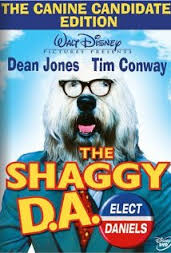
THE SHAGGY D.A.
US, 1976, 91 minutes, colour.
Dean Jones, Suzanne Pleshette, Tim Conway, Vic Tayback, Hans Conreid, Keenan Wynn, Dick Van Patten.
Directed by Robert Stevenson.
A sequel to the late fifties' Disney success 'The Shaggy Dog'. Tommy Kirk turned into a dog when an incantation on a medieval ring was spoken. Now he has grown up into Dean Jones wanting to go for D.A. but continually turning into a dog. This is conventional Disney material of the seventies enhanced by the villainous presence of Keenan Wynn - the villain in many of these films of the time. Susanne Pleshette and Dean Jones and Tim Conway as the befuddled second hero are also regulars. The routines are much less elaborate than usual and so the whole is mildly entertaining.
1. An entertaining Disney film? Overall impact of comedy, fantasy in the middle of real lift? Clean cut American values, villains?
2. The conventions of the genre and the way that they are used: the American family of the seventies, robberies and crime? Honest John and the irony, the politics of the time? Tim and his girl friend and the ordinary people? The satire in the presentation of groups in the city? The humour of Wilby turning into a dog and the various routines? The chases? Better than usual, different?
3. Colour photography, musical score, special effects especially Wilby's changing into Elwood? The use of the conventions of Elvood driving the car etc.? The humour of the dogs talking and the style of this? The humour of such sequences as Tim wanting the dog to speak but it really being Elwood? The overall impact of the effects?
4. The suspension of belief in the credibility of the plot? The Professor and his tour with the explanation of the ring, the reading of the inscription and its effect on Wilby? Coping with turning into a dog and the various devices used by Betty and the family? Honest John and his holding power over Wilby for political purposes? How important was the fantasy element?
5. The character of Wilby and his earnestness - his reaction to the family's being robbed, Betty persuading him to go for D.A., his relationship with his son? The confrontations with Honest John? As a dog relating to Tim? With the robbers? The Police? Betty and her support, managing his campaign? Their son, a typical boy of the seventies?
6. The presentation of Tim for the slow-up evil? Enjoyable material for younger audiences to test their values?
Published in Movie Reviews
Published in
Movie Reviews
Tagged under
Saturday, 18 September 2021 19:43
Shalako
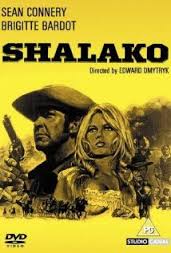
SHALAKO
UK, 1968, 113 minutes, Colour.
Sean Connery, Brigitte Bardot, Stephen Boyd, Jack Hawkins, Peter Van Eyck, Honor Blackman, Woody Strode, Eric Sykes, Alexander Knox, Valerie French.
Directed by Edward Dmytryk.
Shalako is a British-produced western, filmed in Spain. It is based on a novel by celebrated western writer, Louis L'Amour.
The film focuses on a group of European hunters who do not understand Indians or the American terrain. When they are trapped by Indians, they rely on Shalako, their guide, to lead them to safety. Reviewers at the time were very critical of the plot which seemed rather implausible, showing the width(**or was that wit?) of the white guide over the Indians. However, allowing for the loopholes in the screenplay, the film is an entertaining and standard western for the undemanding.
The cast, however, was quite extraordinary with Sean Connery teamed with Brigitte Bardot. Stephen Boyd is the sinister presence and there is a strong cast of British character actors in support.
The film was directed by Edward Dmytryk who made an impression in the 1940s with such films as Murder My Sweet and Crossfire. One of the Hollywood Ten, he had to spend some time in Europe directing before returning to make The Caine Mutiny. He had a very successful career in Hollywood during the 50s and early 60s, with such films as The Young Lions and blockbusters like The Carpetbaggers.
1. How successful a western was this, its impact, entertainment value?
2. What were its best features? How conventional a western? Its use conventions, its differences in highlighting European hunters and the coach and the Indians?
3. How important was the use of a wide range of international stars, the impact for the success of this film? The location photography?
4. The importance of the initial list of hunters in the American west? What attitude did the Italians have towards the hunters? Audience response to them? Their arrogance?
5. How did audiences respond to the hunters? The initial themes in hunting the animals? The appearance of class difference, arrogance, the nature of the table talk, the butler? The nobility? How did the audience response change when the hunters bcome violent? Were they sympathetic when being hunted by the Indians or did they deserve to be hunted because of breaking conventions?
6. How did the film present the Indians? Their rights to to their land and the reservation? Hunting the white man, hunting the hunters? Their cruelty? Audience sympathy for their cause? The clash of the Indian chief with Shalako?
7. How interesting a character was Shalako? Sean Connery in the west? how good a western hero was he? Intelligence and strength? Army background and his ability to lead? the nature of his relatlonship with the hunters? The quality of his love for Irina?
8. How did Fulton contrast with Shalako as a villain? Fulton as a smooth villain? Leading the hunters, trapping and robbing them? Letting Julla die? saving himself with the hunters? Did he merit his death?
9. The character of the Baron and his arrogance in leading the party? His relationship with Irina? The style of his party? The baronial style in the west? Audience sympathy for him in his climbing the mountain?
10. The presentation of the American senator and his wite? The criticism of arrogant American senators? Their attitudes towards the Indians?
11. The English aristocracy in Zagget? His relationship with Julia? Her decision to go off with Fulton? The inevitability of his death? Being left by Fulton, tormented by the Indians? the irony of her checking on her jewels? What point was made by these characters? Zagget’s disillusionment and killing of Fulton? Audience response to this?
12. Was Irina a convincing heroine? Her initiative, her hunting capacity, being rescued from the Indians by Shalako, her relationship to the baron and to Shalako? Brigitte Bardot's interpretation of this role?
13. The presentation of the ordinary men of the west, helping hunting parties, robbing the hunters, being massacred by the Indians?
14. The impact of death in this film? The inevitablity of death in the west?
15. How well did the film explore the themes of greed, violence, brittle relationships?
16. What values did the film presuppose in audiences to enjoy it as a western, as a subtle western?
Published in Movie Reviews
Published in
Movie Reviews
Tagged under
Saturday, 18 September 2021 19:43
Shamus
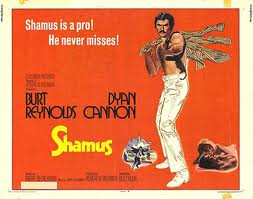
SHAMUS
US, 1973, 108 minutes, Colour.
Burt Reynolds, Dyan Cannon, John B. Ryan, Kevin Conway, John Glover.
Directed by Buzz Kulik.
Shamus is what might be called a typical Burt Reynolds action film of the 1970s. He plays a private eye detective who likes the easy life. However, lacking prospects in business, he is happy to take on a ten thousand dollar case to recover some diamonds. This involves him with the Mob, with all kinds of athletics as he moves through the various boroughs of New York. He also gets the chance to romance Dyan Cannon. Easy entertainment in the Burt Reynolds vein.
1. Was this just another private eye thriller or was it something more?
2. What kind of character was Shamus? Was he want to be typically modern in any way? How?
3. In films like this, the methods of the man on the side of right seem to be indistinguishable from those of the criminals. Was this true here? What standards for his profession did Shamus have? for himself? What did he consider right and what wrong?
4. Was the film too brutal - throwing death, the faces in the garbage, the bashings? or were they necessary for this kind of film? Why?
5. How bad were the criminals? How cruel? their murdering of brothers and of the little man with the memory, the military officer?
6. Why did Shamus press on with his investigations when he realised that his employer was involved?
7. How involved did Shamus get with Alexis? What kind of woman was she? Did they have any lasting future together?
8. What is the value of this kind of film? entertainment only? What attitudes to law and order, justice and right does it presuppose?
9. The film laced its investigation and violence with humour. How did this work well? Improve the film? how?
Published in Movie Reviews
Published in
Movie Reviews
Tagged under
Saturday, 18 September 2021 19:43
Shape of Things to Come, The
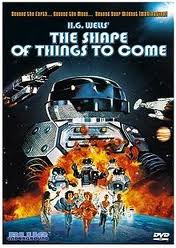
THE SHAPE OF THINGS TO COME
US, 1979, 98 minutes, Colour.
Jack Palance, Carol Lynley, Barry Morse, John Ireland, Nicholas Campbell.
Directed by George Mc Cowan.
Yet another Star Wars' derivative like Star Crash, The Humanoid and the Galactica series. The title is from H. G. Wells but otherwise the film has nothing to do with his work or the film, Things to Come made in the thirties by William Cameron Menzies as a forecast about World War II and its consequences.
However, Wells was always interested in popular science fiction. TV director George Mc Cowan (who made the animal horror classic 'Frogs') directs a routine cast which includes a villainous Jack Palance and Carol Lynley as an unlikely ruler of a galactic planet. The film has the usual technological effects, presentation of space, moon inhabitation and a genial robot called Sparks. Enjoyable but derivative.
1. the impact of Star Wars and its derivatives in the seventies? Audience interest in space, space exploration, wars? Influence of H. G.Wells and the use of his title?
2. The appeal of science fiction and fantasy? A possible world, the future, coping with the future in the light of the way of coping with the present? The conventions of Star Wars material, the derivation and lack of originality?
3. The audience interest in technical aspects of space exploration and warfare: the visualizing of space, the cities and the inhabitation of the moon and other planets, technological development in the cities, in the spacecraft, in the wars? The backgrounds of robots and the robot wars of their destruction? Genial robots? Such devices as the creation of images in the sky? Technology for creation and destruction?
4. The impact of the special effects of the film, entertainment, excitement?
5. The introduction of the civilisation of the moon and the introductory explanation? New Washington, its appearance, inhabitants, the threat of the crash and its actual destruction? The threats of radiation and the need for safeguarding drugs? Politics, the senator, the development of new space vehicles, disputes?
6. The collision and the build-up of tension, the powerful ruler of Delta Three and his attack on the moon, his background as a scientist and his development of techniques, his megalomania and power, his use of robots? His deposing Nikki, the former ruler, his control, his aims of destruction and the irony of his being destroyed by his own devices?
8. The hero and heroine and their age, technological background, relationship with their parents? Their decision to go to Delta Three, their visit to the Earth, exploration and suspense, the encounter with the children? Delta Three and their confrontation of the ruler, the meeting of Nikki and the rescue, the excitement of the escape, the confrontation of the villain, the danger of the return and the high speeds, their survival? Comic book hero and heroine for this kind of film - audience expectations of how they should behave and succeed?
9. The scientist and his development of spacecraft, clash with the senator, his decision to go to Delta Three to confront the villain, his experience of radiation, his illness during the voya ge, support, his death?
9. Sparks and the genial robot, his skills, swift movement, need for his moving against the villain? repairs?
10. The children and their hiding, victims of the robot wars? their need for rescue?
11. Nikki and her story, her faithful followers, their training, attempts at eacape, their deaths?
12. The build-up of the climax and the destruction of Delta Three, the escape through space, peace in the galaxy? The perennial appeal of this kind of matinee material no matter what the guise?
Published in Movie Reviews
Published in
Movie Reviews
Tagged under
Saturday, 18 September 2021 19:43
Shark!
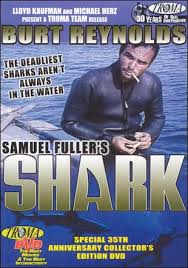
SHARK!
US, 1969, 92 minutes, Colour.
Burt Reynolds, Arthur Kennedy, Barry Sullivan, Silvia Pinal.
Directed by Sam Fuller.
Shark! predated Jaws by seven years. However, it is remembered for tragedy associated with the film, the death of one of the cameramen during filming. Their followed a dispute with the director, Sam Fuller, who did not want the death used in the advertising for the film. The producers insisted. When Fuller left the film, it was recut by the producers and the director disowned it.
Shark! then becomes a footnote in the career of Sam Fuller who directed some tough action films in the 1950s and made his autobiographical classic The Big Red One in 1980, covering World War One and World War Two.
Burt Reynolds was at the beginning of his film career at this stage. Arthur Kennedy and Barry Sullivan were veterans. Silvia Pinal was a Mexican leading lady.
The film does not contribute particularly much to the shark genre.
1. The emphasis of the title and audience expectation? The alternative title was Caine (as well as Maneater) focussing on the hero. Which more appropriate?
2. The film’s adventure qualities? Average or more?
3. The importance of locations, Africa and its terrain, the town and its atmosphere, the Red Sea?
4. The initial shark sequences and their impact? Their reprisal during the film? The chorus of the shark swimming close? The shark as the instrument of retribution?
5. What type of hero was Caine? The way that he was introduced? His desire to get out of the town? His friendship with Runt? Relationship with the doctor and the police? Working for the professor? Relationship with the woman? His quest for the gold?
6. Was his character well developed? The Burt Reynolds type? The twists in the characterization, especially the ending?
7. The sultry and selfish woman? Her own ends? The retribution?
8. The professor, a conventional character, his death?
9. The portrayal of the doctor, the drunk in an out-of-the-way town? His contribution to the plot, the operation?
10. The picture of the police, and the twist of the corrupt police chief?
11. The emphasis on the people in the town? The flavour and the atmosphere?
12. The impact of the diving sequences, the climaxes?
13. The quality of the film as entertainment, story, types?
Published in Movie Reviews
Published in
Movie Reviews
Tagged under
Saturday, 18 September 2021 19:43
Shark's Treasure
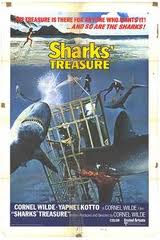
SHARK'S TREASURE
US, 1975, 95 minutes, Colour.
Cornel Wilde, Yaphet Kotto, John Neilson, Cliff Osmond.
Directed by Cornel Wilde.
Shark’s Treasure is less about sharks than about treasure. This is a story about a charter skipper and a team who look for treasure – and have confrontations with sharks but also with escaped convicts. This makes it an action adventure and a pursuit film.
It was written and directed by Cornel Wilde. Wilde was a romantic lead in films of the 1940s including his Chopin in A Song to Remember. However, from the 1950s he became interested in directing as well with films like The Big Combo, Storm Fear and The Naked Prey.
1. The significance and tone of the title? The ambiguity? The real sharks and the criminal sharks?
2. What were audience expectations of this film? A shark film? A film about buried treasure? How well were these expectations fulfilled?
3. How well produced and filmed was the work? The use of colour, locations, underwater photography, music, the song about money, the editing etc.?
4. How good was the film as an adventure? The characters and their ruggedness, exciting sequences, suspense? How much was the film geared for masculine adventure audiences?
5. The film's theme of treasure and its attraction? Its hold on men, the achievement in finding treasure, motivations, greed, courage, skill? The risks to life? The in-fighting? The greed of criminals?
6. Why do audiences have interest in this kind of treasure adventure? How important is it for interest in the characters as well? How well was this achieved here?
7. How impressive a hero was Jim? An ageing, Cornel Wilde who also wrote and directed the film? The emphasis on his fitness and skill? His messages about smoking, drinking, unnecessary violence? His shrewdness? Yet his approach to others and misunderstanding them? His capacity for fighting, saving his crew? His relationship with Ron? What were his basic attitudes? Towards Ben and his attitudes towards others? How typical a modern American?
8. How did he contrast with Ron? A young man an the make? Eagerness and disappointment in not finding the treasure? Participation in the work? His dreams of a solid future? (The message here for a younger generation?) The disappointment when the pirate criminals came? What had he achieved by the end of the film?
9. Ben as a character? A skilful diver? Being black? What had he achieved by the end of the film?
10. The atmosphere of Mexico, the po1ice and the shooting, the bar, the deal with the barman, the daughter and her seduction for information etc.? Adventure ingredients? The importance of the convicts? What kind of men in themselves? Repellent? Violent? Sadistic? The threat to the treasure crew?
12. How well did the film make the transition from treasure adventure to convict thriller? The suspense moving to menace?
13. The character of Lobo? How skilfully was this character comunicated? His leadership, weakness, hold over the crew? Johnny? The nature of his attachnent to Johnny, sadism, the nature of his death?
14. Johnny as a paranoid? Lobo's influence, his brutal treatment, his decision to rebel, his running away from Lobo, the nature of his death?
15. How much insight went into the characterization of the criminals, the minor criminals also?
16. The theme of survival? How important was this on the ship, not provoking violence, using wits, escaping, the scene on the boat, on the island?
17. How skilful were the scenes of the escape and the sea?
18. The final fight as a climax for this kind of film, the comment on not shooting the Chinese criminal?
19. Comment on the shark sequences, the danger of the sharks, the way they were filmed, the fierceness, even breaking into the safety cage etc.? The risk to life and limb for treasure In such shark-infested waters?
20. The attention to detail of getting treasure from the bottom of the sea?
Published in Movie Reviews
Published in
Movie Reviews
Tagged under